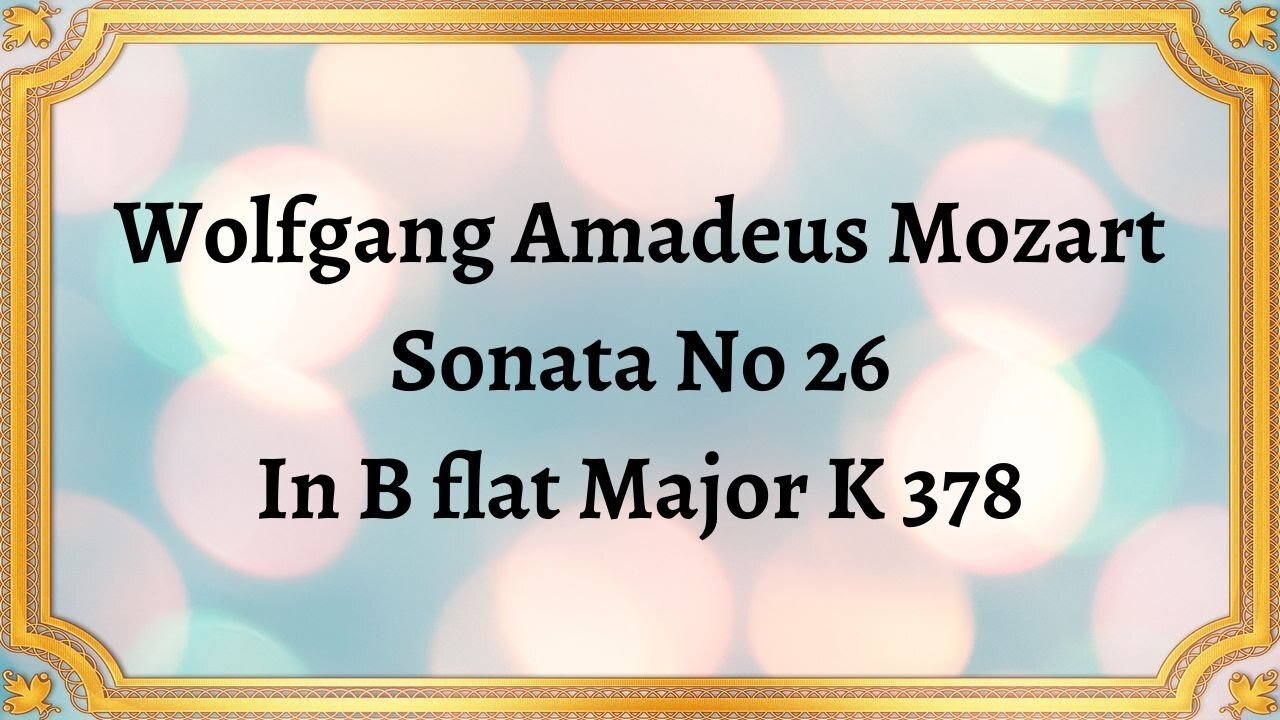Premium Only Content

Wolfgang Amadeus Mozart Sonata No 26 In B flat Major K 378
#WolfgangAmadeusMozart #SonataNo26 #InBflatMajor #K378 #classicalmusic #musicalcomposition #Allegromoderato #Andantinosostenutoecantabile #Allegro #musicaltechniques #piano #musictheory #musicalstructure #harmony #counterpoint
Publication date 1950
Isaac Stern; Alexander Zakin
Wolfgang Amadeus Mozart's Sonata No. 26 in B-flat major, K. 378, is a remarkable piece of music from the Classical period. It was composed in 1779 for the keyboard instrument, most likely the piano forte.
The sonata consists of three movements - Allegro moderato, Andantino sostenuto e cantabile, and Allegro. The Allegro moderato is a fast and lively movement, filled with contrast and variation, showcasing Mozart's virtuosity and command of musical language. This movement is marked by its shifting tonality and use of varied themes, which give the movement an exciting and unpredictable feel.
The Andantino sostenuto e cantabile is the second movement of this sonata. It is a slower section, characterized by its lyrical melody and expressive harmonies. Unlike the first movement, the Andantino is more melancholic and introspective, balancing the energy of the Allegro with a more contemplative mood. The subtleties and thoughtful nuances throughout this movement make up some of Mozart's most beautiful moments in his compositions.
The final movement of Sonata No. 26 is an Allegro. The movement begins with a playful and lively theme that Mozart soon develops into another glorious composition filled with bright and fast musicality. Mozart's cyclical return to the opening theme reflects his ability to create coherence in an entire work, linking different movements and parts of the musical work into a single musical entity.
Sonata No. 26 in B-flat major, K. 378 marks Mozart's maturation as a composer and showcases his unparalleled integration of technical mastery and artistic expression. A significant feature of this sonata is Mozart's use of musical techniques, such as ornamental decorations, harmony ideas, and counterpoints, to provide momentum to the composition's overall structure and keeping it engaging and cohesive.
In conclusion, Wolfgang Amadeus Mozart's Sonata No. 26 in B-flat major, K. 378, is a masterpiece of the classical music era. The sonata is an excellent example of Mozart's evolving compositional prowess and direction and demonstrates his mastery of musical language, structure, and techniques. Through the three movements, his artistry is vividly expressed and is a delight and wonder to listeners to this day.
You have the opportunity to support the channel https://destream.net/live/RadSiarAl/donate
-
 20:26
20:26
Classical music_Music Inspiration
1 month agoJohann Sebastian Bach Orchestral Suite No. 2 in B minor, BWV 1066
742 -
 2:59:21
2:59:21
TimcastIRL
3 hours agoTrump Calls Epstein Case A HOAX By Democrats, GOP Votes TO BLOCK Release | Timcast IRL
172K136 -
 10:17
10:17
Dr Disrespect
12 hours agoIt's Time To Get Serious
2.67K8 -
 LIVE
LIVE
SpartakusLIVE
5 hours agoDuos w/ Sophie || Charity stream tomorrow!
336 watching -
 58:43
58:43
Sarah Westall
4 hours agoBecause Voluntary Extermination is a Thing: Israel-Gaza w/ Award Winning Journalist James Robins
13.5K8 -
 LIVE
LIVE
BubbaSZN
5 hours ago🔴 LIVE - TRYING TO NOT BUST A$$ THIS TIME (THPS3+4)
66 watching -
 LIVE
LIVE
sophiesnazz
8 hours ago $0.91 earnedGENUINE BELTERS IN ERE l LIVE WITH @SpartakusLIVE!socials
98 watching -
 1:15:18
1:15:18
Glenn Greenwald
6 hours agoTrump Promises More Weapons for Ukraine; Trump Again Accuses Dems of Fabricating Epstein Files | SYSTEM UPDATE #487
107K74 -
 LIVE
LIVE
This is the Ray Gaming
1 hour agoTuesday Night is FOR THE BOYS | Rumble Premium Creator
76 watching -
 LIVE
LIVE
RaikenNight
2 hours agoDon't know what to play so I am doing a hangout stream
37 watching